When your cat pees in the water bowl, it can be both puzzling and concerning. As a pet owner, you might wonder what’s driving this unusual behavior.
It’s important not only because it deviates from your cat’s habits but also because it can indicate underlying health issues or environmental stressors.
Understanding why your cat is displaying this behavior is the first step toward finding a solution. Cats may pee in water bowls due to stress, health issues, or dislike of water bowl location. (1)
Ensure the bowl is cleaned and in a quiet spot. If the behavior continues, consult a vet to rule out any underlying medical problems causing this unusual behavior in your cat. (2)
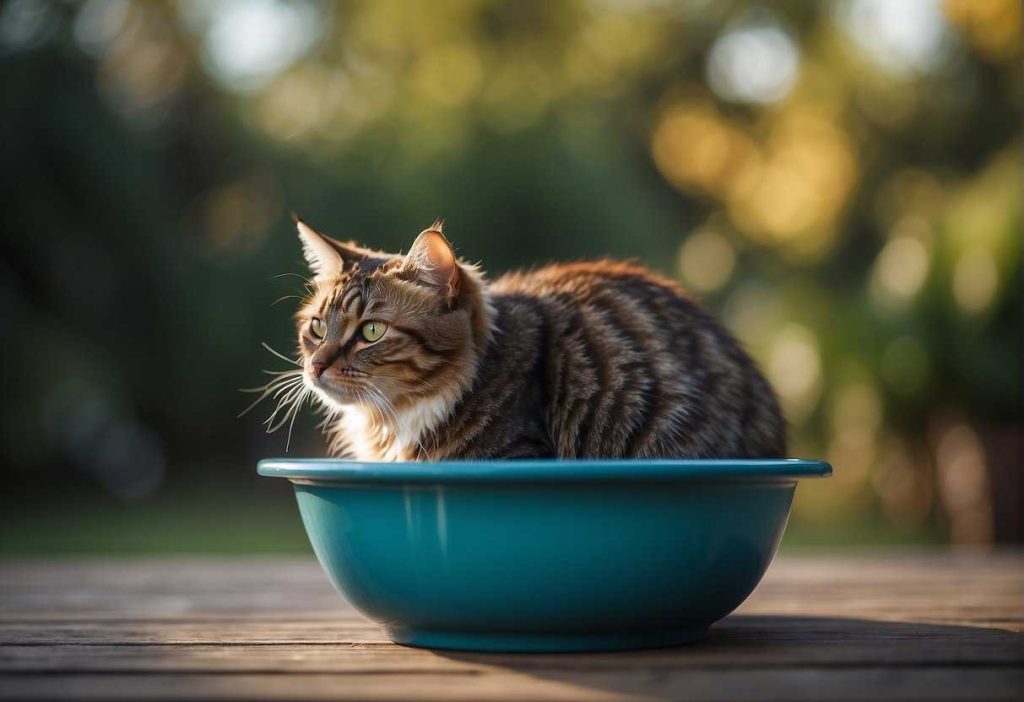
Cats are well-known for their cleanliness, so when they begin to urinate where they drink, it raises a red flag. Distinguishing between a medical condition and behavioral causes is crucial.
A trip to the vet can rule out any health concerns, while taking a closer look at your cat’s environment may reveal stress triggers.
Identifying and addressing these can help restore your feline’s normal behavior and prevent recurrence.
Key Takeaways
- Identifying why a cat is urinating in its water bowl is essential for its health and well-being.
- Differentiating medical from behavioral causes is crucial for resolving this issue.
- Consulting a vet and evaluating the cat’s environment can help stop the undesired behavior.
Cat Peeing in Water Bowl: Addressing the Issue with Actionable Strategies
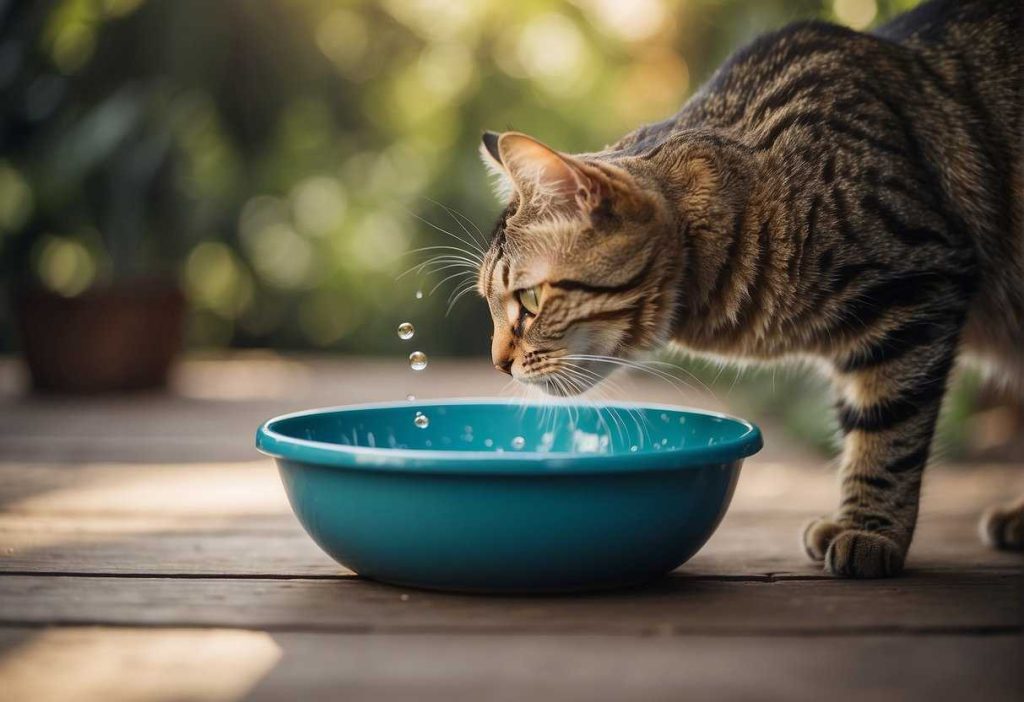
Immediate Actions to Take:
- Relocate: Move that water bowl! Maybe your furry friend seeks privacy, or the bowl is too close to their food or litter box. Cats are picky!
- Clean Up: Ensure the water bowl is squeaky clean. A quick rinse isn’t enough; scrub-a-dub-dub that bowl to keep it fresh and inviting.
Long-Term Behavioral and Environmental Modifications:
- Puzzle Feeders: Spice up their life with environmental enrichment like puzzle feeders. Cats love a good challenge! It keeps their mind off unsavory water bowl habits.
- Scratch Posts: Offer ample scratching posts or pads. Cats need to stretch and scratch, it’s their way of unwinding.
- Consistent Routine: Cats are creatures of habit. A stable routine eases anxiety, which can sometimes lead to those aquatic indiscretions.
Now remember, don’t just pounce on these suggestions. Introduce them gently to keep your kitty purring.
Differentiating Between Medical and Behavioral Causes
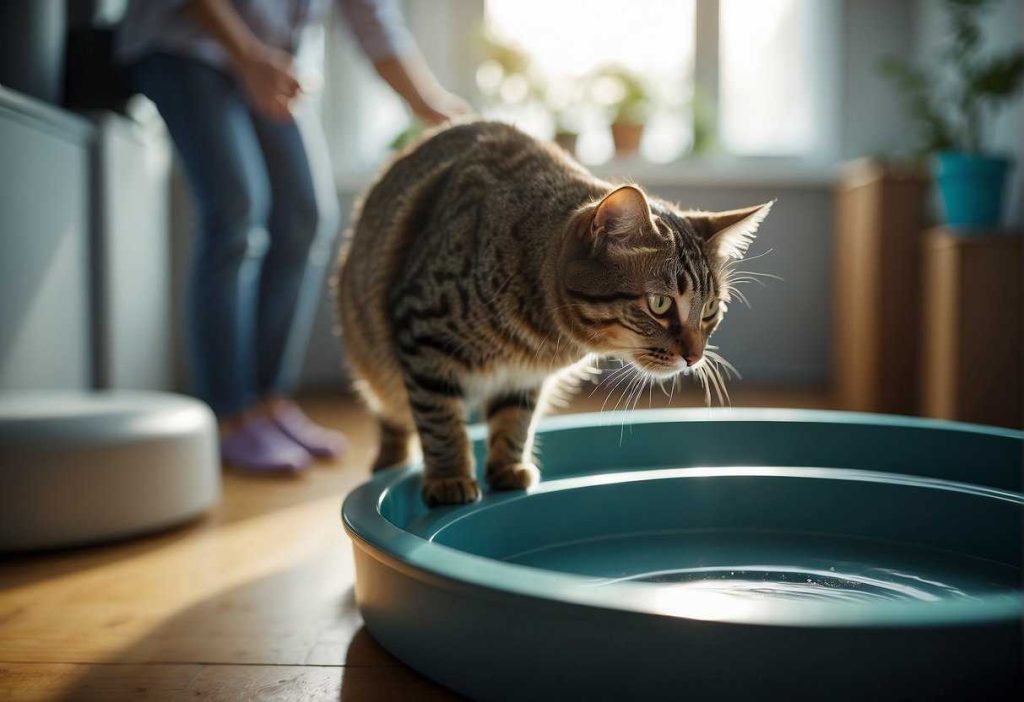
Signs Indicating Medical Issues
When your cat suddenly forgets their litter box manners, it’s not just to drive you bonkers! It could be a cry for help. Here’s what might point to a vet-worthy concern:
- Frequent Attempts: If they’re visiting their bowl more than the snack drawer, take note.
- Discomfort: Watch for signs of pain or straining. No one likes a painful bathroom break!
- Blood in Urine: This is a definite red flag, never to be ignored. (3)
- Lethargy: Too pooped to play? Not your kitty’s usual zest. (4)
- Excessive Drinking: If they’re lapping up more water than usual, something may be up.
Identifying Behavioral and Environmental Triggers
Think of your cat’s world like a furry soap opera—full of drama and complex relationships. Your cat’s peeing problem?
- Stress: New pet in the house? Or maybe you’ve moved their bed for the tenth time? (5)
- Territory Issues: Multi-cat household? Your cutie might be saying, “This bowl is mine!” (6)
- Environmental Changes: Did you switch up their litter or spiffy up the house with new scents?
If you’re nodding along, take a deep breath. With some detective work and perhaps a vet visit, you can help your kitty get back on track.
Remember, they’re not splashing around to make a splash—it’s their way of telling you something’s afoot!
Leveraging Expertise to Understand Your Cat

Consulting with Veterinarians and Behaviorists
When your cat starts doing the unexpected, it’s time to turn to the pros.
Your vet can rule out any medical issues, like a urinary tract infection, which could be causing the behavior.
And behaviorists? They’re the detectives of the cat world. They look at the clues in your cat’s environment and habits to figure out the why behind the what.
- Veterinarian: Rules out medical issues
- Behaviorist: Investigates environmental and behavioral factors
Learning from Success Stories
Everyone loves a happy ending, especially when it involves our pets. By looking at case studies, you can uncover successful strategies others have used.
For example, perhaps changing the type of water bowl or its location was the key to someone else’s kitty.
Here’s the takeaway: address your cat’s quirky behavior with a mix of professional advice and real-world success stories.
You’ll make your life—and your cat’s—a whole lot easier. After all, there’s nothing quite like solving a mystery with a little help from your friends in the know.
Avoiding Future Incidents
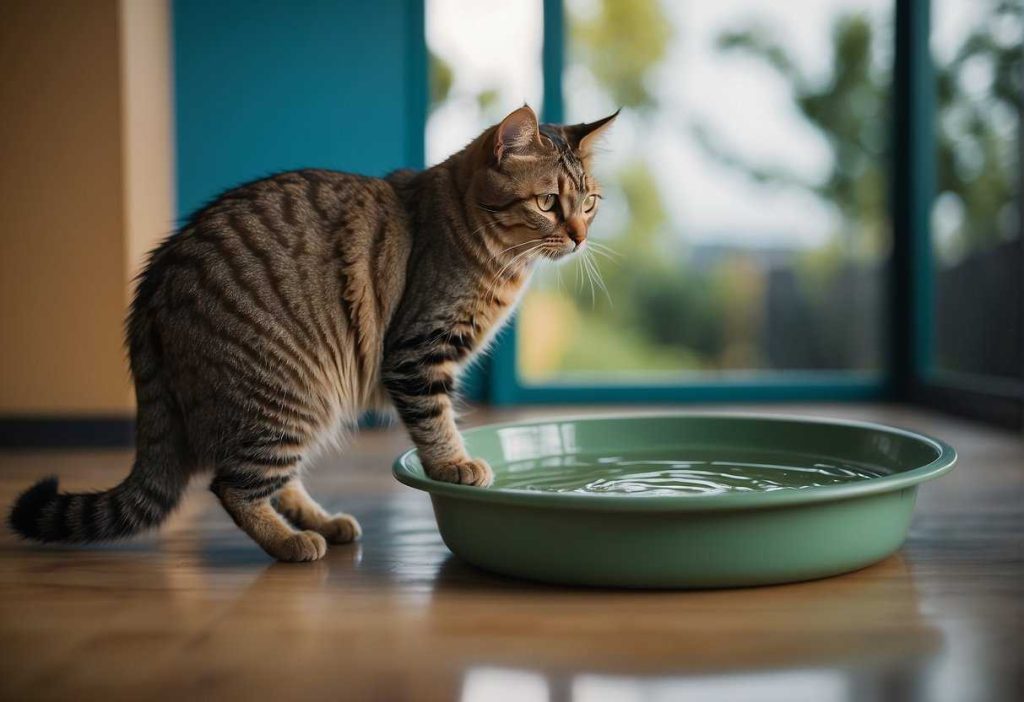
Routine Veterinary Check-ups
First off, stay on top of your furry friend’s health with regular veterinary visits. Why, you ask?
Because peeing outside the litter box can sometimes be a sign of health issues. Catching these early can save you and your kitty a lot of trouble!
- Annual exams: Essential for spotting anything out of the ordinary.
- Urinary health: Specific check-ups can prevent or identify issues early on.
Maintaining a Clean and Enriching Environment
Cats are pretty neat creatures, and they crave an environment that mirrors that.
- Tidy up: Keeping their space clean is a big deal. No one likes a dirty bathroom, right?
- Playtime: Interactive toys can go a long way in keeping boredom at bay.
- A place of their own: Cats love having a spot they can retreat to.
Don’t forget, that stress can sometimes lead to these unexpected behaviors.
So, by creating a chill zone, you’re not just updating your home decor—you’re also giving your cat an all-access pass to relaxation city.
Remember, with a touch of vigilance and some proactive care, you can curb these watery woes.
Keep these points in your toolbox, and you’ll be well on your way to fostering a happy, healthy relationship with your little whiskered pal.
Let’s keep the water bowl for drinking and the litter box for everything else, shall we?
Connecting with Others for Support and Advice
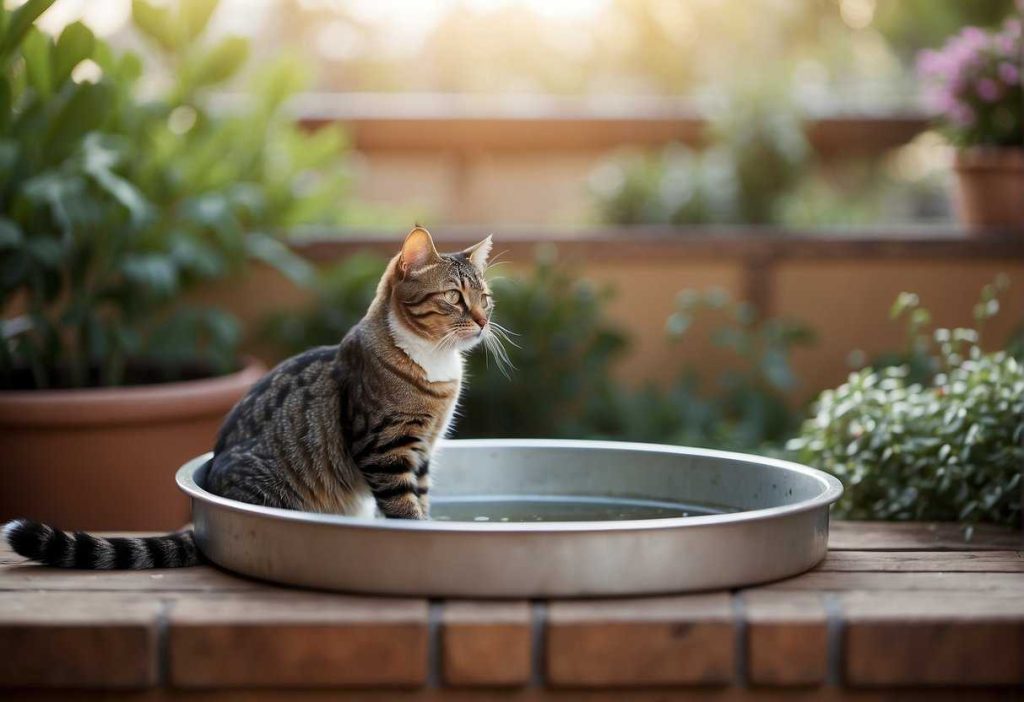
Online Forums and Communities:
- TheCatSite.com: A treasure trove of cat-centric knowledge where you can post your query and get responses from seasoned cat lovers.
- Reddit’s r/Pets: Engage in discussions or browse through a variety of topics, including the odd water bowl habits of cats.
- Facebook Groups: Local and global cat lover groups on Facebook can prove invaluable. Find one that resonates with you and jump right in!
Support Groups:
- Local Vet Clinics: Often have support groups or can point you to nearby resources.
- Rescue Organizations: Connect with experienced volunteers who’ve seen it all.
| Source | Description |
| Veterinarian | Medical advice and best practices |
| Cat Behaviorist | Understanding feline psychology |
Tips for Asking for Advice:
- Be specific about your cat’s behavior.
- Share any steps you’ve already taken to solve the mystery.
- Maintain a polite and appreciative tone – quick responses will follow.
Remember, there’s power in the community; a swift solution could be just a conversation away.
Have you reached out for advice yet? No? Go on, give it a shot! Your kitty will thank you – with a purr, of course!
Staying Informed on Feline Behavior and Care
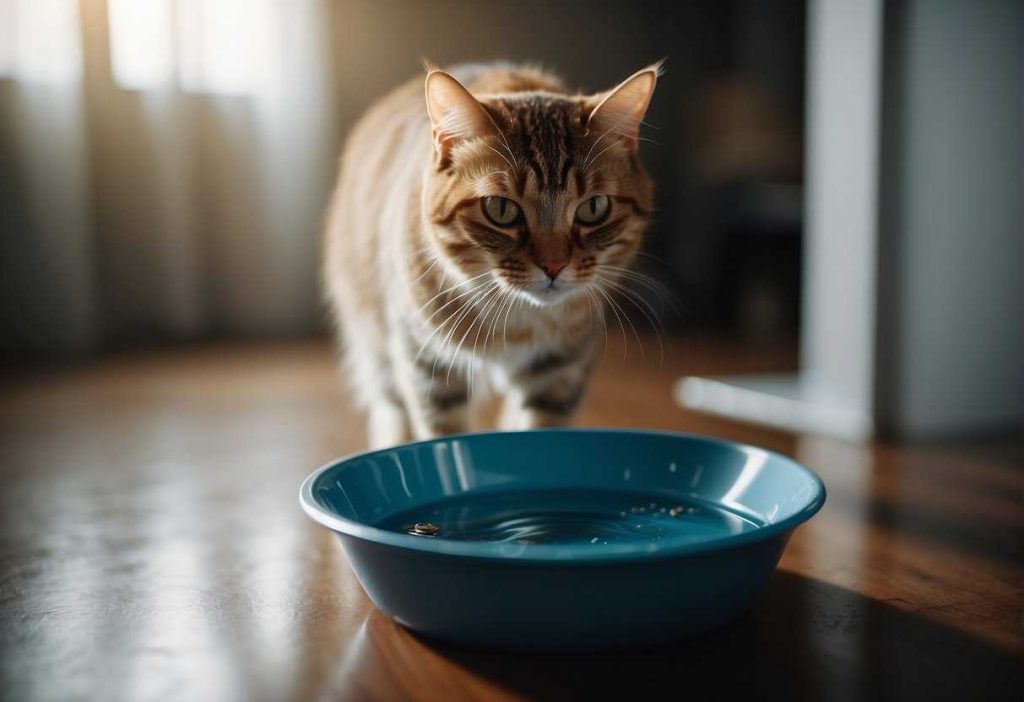
Staying on top of their quirky behaviors is all about keeping informed about the latest feline care practices. Let’s dive into a few ways you can continue to be the best cat parent around by tapping into new findings.
Recent Research
- What’s New?: Discoveries about feline hydration preferences (7)
- Why Monitor?: Early detection of health issues derived from abnormal behaviors
Resources
- Veterinarians: Direct line to expert advice
- Online Forums: Real-time experiences from fellow cat owners
- Pet Journals: Studies on latest behaviors and health recommendations
Implementing What You Learn
Want to do what’s best for your kitty? Keep your eyes peeled for the most up-to-date research.
Websites like ‘The International Society of Feline Medicine’ often publish insightful articles on cat behavior.
Also, chatting with your vet can highlight the importance of observing changes, like a new hobby of peeing in their water dish.
Community Support
- Connect with other cat enthusiasts on platforms like ‘Reddit’s r/cats’
- Look for local pet groups and get involved
Remember, the average cat owner might not have all the answers, but a community often does.
And it’s okay to admit you’re stumped on what makes your cat tick—everyone’s learning.
Your vigilance and willingness to learn about feline behavior and care not only make you a great cat owner but also ensure your furry friend lives their happiest life.
Keep those whiskers twitching with curiosity as you and your cat embark on a journey of mutual growth and understanding!
Quick Recap

Have you noticed your furry friend treating their water bowl like a toilet? Let’s address this quirky behavior.
- Understanding the Issue: Cats are fastidious creatures and typically don’t mix their eating and bathroom areas. If your cat pees in their water bowl, it may signal a health issue or behavioral problem.
- Immediate Solutions: Clean the bowl and the area to remove any lingering odors. Consider changing the type of bowl or its location.
- Long-Term Strategies: Monitor your cat’s behavior and health. Ensure your cat has easy access to a clean litter box at all times.
Why is this important? A happy cat means a happy home. Ignoring this odd habit could lead to bigger problems down the road.
Are you ready to tackle this head-on?
With a sprinkle of attention and a dash of care, you can guide your cat back to more appropriate bathroom habits.
- Resources to Utilize:Veterinarian: If the behavior persists, seek medical advice.
- Behaviorists: They can offer tailored solutions.
Remember, addressing your cat’s peculiar water bowl behavior is not just about damage control—it’s about understanding and caring for your furry pal.
So, roll up your sleeves and become a detective in your own home—it’s time to solve the purr-plexing case of the water bowl mystery!
Frequently Asked Questions
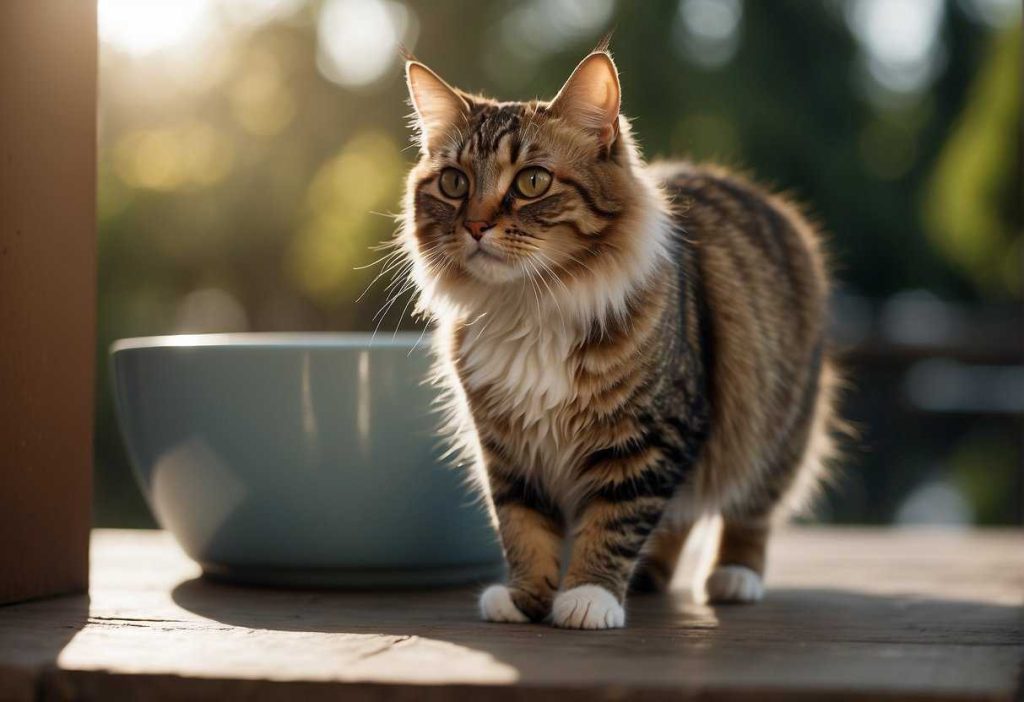
When your cat starts using the water bowl as a litter box, it’s natural to have questions. Here’s a quick rundown of the common queries cat owners have regarding this peculiar behavior.
Why is my cat suddenly peeing in the water bowl?
Your feline friend may be marking its territory or displaying dissatisfaction with its current environment.
Changes in the household or the placement of its essentials could be tipping the scales.
Could a medical condition be causing my cat to pee in the water bowl?
Yes, issues like urinary tract infections, diabetes, or kidney disease could provoke this. It’s essential to consult your vet promptly to rule out or treat any medical concerns.
How can I stop my cat from peeing in the water bowl?
Start by ensuring the litter box is clean and appealing and consider its location and accessibility.
You might also want to try different types of litter or introduce an additional box.
What are the signs that my cat’s water bowl behavior is stress-related?
Keep an eye out for other changes in behavior, such as reduced appetite, excessive grooming, or a decline in interaction. These can signal that stress is the culprit.
How often should I clean my cat’s water bowl to prevent this behavior?
Clean the water bowl daily with soap and water to maintain hygiene and make it less likely your cat will mistake it for a bathroom spot.
Can changing my cat’s litter box location or type help?
Cats are particular about their privacy for bathroom breaks.
A quiet, less trafficked area is ideal, and the size and style of the litter box can also make a big difference.
Is it possible my cat doesn’t like the type or location of its water bowl?
Indeed, cats may avoid a water bowl that’s too close to their food or in a busy area.
Try relocating it to a more serene spot and consider a shallower or wider bowl that doesn’t whisker-stress them.


